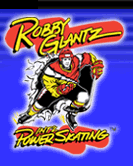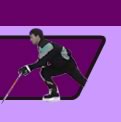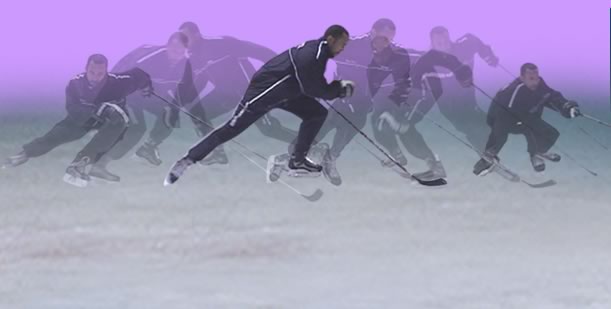Generating Speed with the Puck
One of the most frequently asked questions that we receive in regards to our Power Skating Program is, Do you guys utilize pucks at your camps? My standard answer is in the form of another question, Do they use pucks in the game? Of course· then we most definitely use pucks at ALL of our camps! I can only speak for what we do at our Power Skating Schools and Clinics, but I think there is a common misconception about Power Skating and our use of pucks and/or game situation drills. Coming from a hockey background, I always felt (and still feel this way) that there had to be more in the way of simulating game situations and tempo in our training, while still teaching proper techniques for more speed and overall better hockey skating.
Therefore, we instituted the more up-tempo, overspeed and resistance drills that I prefer at all of our programs, as well, we show the proper techniques for HOW to perform EVERY skating maneuver we teach, WITH THE PUCK. In this month's article we will focus on these techniques for better skating while carrying the puck.
ONE HAND VS. TWO HANDS ON THE STICK· THEY ARE BOTH IMPORTANT:
Having one hand on the stick allows your arms to free up and stretch more (make sure the stretching motion of the arms is to the front, where you want your speed to go and not across your body or side to side), which in turn, allows your legs to stretch more as well (stretching the legs fully to the side is vital for gaining more speed). However, we also teach how to generate speed with two hands on the stick as well. With two hands on the stick the armswing will be more side to side, but this should not take away from your speed if the hands are kept low (along with the kneebend) down by the knees and stretching in control in a straight across motion.
Therefore, it is fair to say that they are both vital in hockey and players would be wise not to ignore either. Practice both one hand on the stick (especially when building up speed) and two hands on the stick (especially when you approach the offensive zone).
FORWARD STRIDE WITH THE PUCK (ONE HAND ON THE STICK):
As I discuss above, try to maintain one hand on the stick when trying to get to top speed in the forward stride with or without the puck. In order to maintain your same speed that you get without the puck, you need to follow a couple of very important techniques, that are the same no matter what your level of play:
As always you must maintain excellent kneebend, remember to bend the knees to about 2° out over the toes of your skates, with your back straight (try to keep your chest equal with your front or gliding knee, so you do lean slightly forward but with the back straight) and your head up.
It is vital that you learn to skate with and without the puck with your head up, so that you can see the play. And remember, that you can not only see the puck with your eyes up (using peripheral vision to see out of the corners of your eyes), but that should be able to ãfeelä the puck at the end of your stick as well·so there is no need to stare at the puck or the ice.
Try to keep your hands above your knees. When your hands get below the knees you will have a tendency to bend too much at the waist which will mess up your forward stride technique by throwing your balance too far forward.
Keep your stick (which should be cut below your chin when on skates) in your top hand on the backhand side, with your palms facing directly up to the sky. Keeping the palms up will help to maintain the stick in the proper position, flat on the backhand, throughout.
Have the stick stay on the side of you almost a full stick length away from your body, perpendicular to the direction you are travelling, even while your hands stay under your body. This way you are able to push the puck along the side of you, rather than in the middle (when the puck comes to the middle of your body, you will most likely have to straighten up or begin to stickhandle with two hands).
Naturally, it is impossible to be perfect, so if the puck does come to the middle, it is of course okay to stickhandle, or since we are talking pure speed here, you should try to forehand it (by snapping your wrist outward), back over to the backhand side so you are able to maintain your stride.
Even though you have the stick and the puck off to the side of your body, you still should fully stretch the arms in a forward and back motion (do not pass your bellybutton). To do this with the puck, practice pushing or punching your fingers in front of your stickblade so that the blade can drag slightly behind as it contacts the puck.
Try to push the puck each time your stick hits it a couple of feet along the side of you, rather than trying to drag or carry the puck· Remember that the puck can move faster than you can, so let it do the work for you by getting it out there so you do not need to slow down for it.
BE PATIENT AND PRACTICE:
To get a better idea of these techniques, simply watch a Paul Kariya, Peter Forsberg or Jeremy Roenick, just to name a few of the best, as they break out of the zone with the puck. You will see how they get that puck on the side of them and maintain the same stride and speed when they have it. If you look closely, you will see that even though it looks like these great players have the stick attached to there stick, that in fact, they are actually pushing the puck and letting it go to work for them, and that there technique with puck is exactly the same (even while their strides and styles of playing the game are all different).
Finally, I would be remiss to mention that these techniques described above definitely do not come overnight. In fact, all of my Instructors (myself included) struggled for months and months with these techniques until we finally felt comfortable to perform them at top speed. It simply took an understanding the proper techniques described above and then lots of repetition and practice to implement them. So, donât get discouraged, be aware that the stars mentioned above make it look so easy because they have a great understanding of proper fundamentals and then they work tirelessly at improving them.





